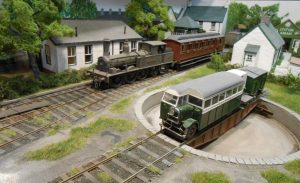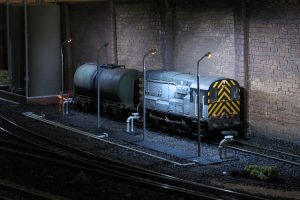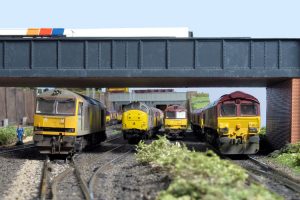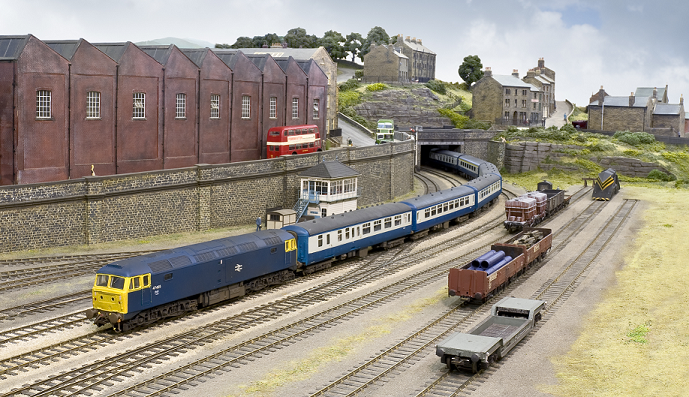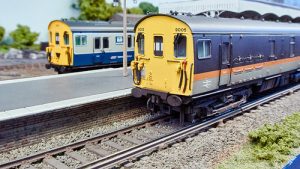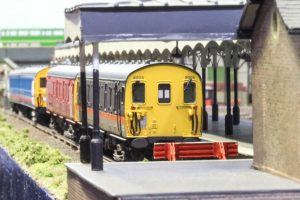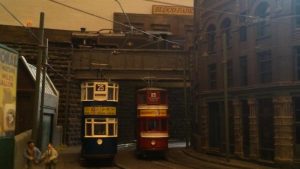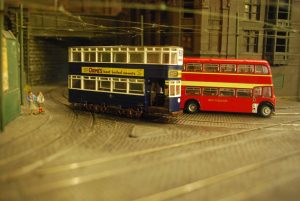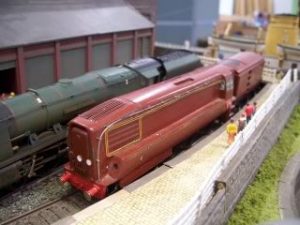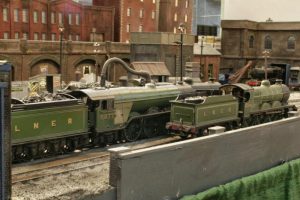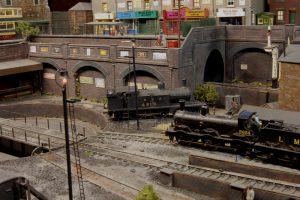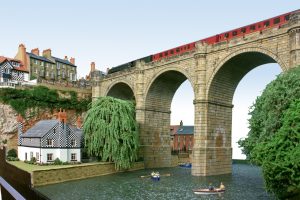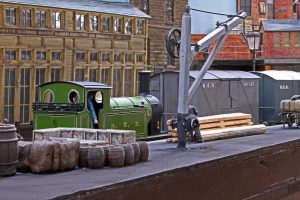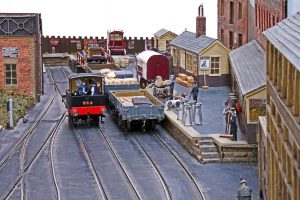To see what you missed in 2016. Here is a video filmed by one of our visitors
Thanks to acw71000 for permission to include this video
Twenty layouts accepted invitations to appear this year (two more than in 2015). Most of them have appeared in one or more railway modelling magazines in the last two years.
Less than 4mm=1ft 4mm=1ft More than 4mm=1ft
Forthtal Schmalspürbahn Crimson Road Arigna Town
Heatherley Dewsbury Midland Seabury Town
Melton Mowbray (North) Elcot Road The End of the Line
Murfitt Grime Street Water Street Sidings
Shasta Kepier Colliery
Llantwyn
Museum of Transport
Portchullin
Salmon Pastures
Sodor North-Western
The World’s End
Further details on each of them (listed in alphabetical order) can be found below.
Arigna Town (7mm fs, 36.75mm gauge)
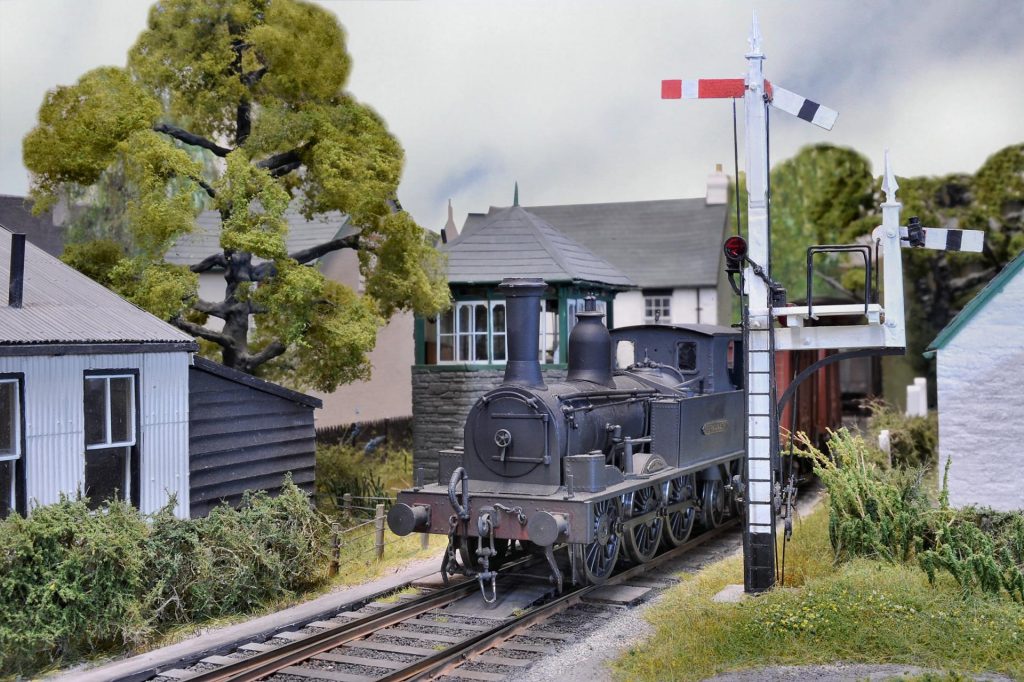 Arigna Town is a fictitious branch line of the Sligo, Leitrim & Counties Railway in NW
Arigna Town is a fictitious branch line of the Sligo, Leitrim & Counties Railway in NW
Ireland. The SLNCR opened in 1882 and closed in 1957, remaining independent for its whole history. It ran from Enniskillen to Sligo and the main traffic was cattle. However, to the south there are coal mines and the layout assumes a branchline was built to tap this traffic. The model is built to the correct Irish broad gauge and everything on the layout has been handbuilt, mostly from scratch, though the three steam engines are from kits. Wagons come from original resin castings or are hand built from plastic sheet with whitemetal castings.
The trains are representative of the real SLNCR, with a railbus and railcar for passenger traffic and steam hauled freight. Display boards give an outline of what is on show.
Arigna Town was featured in the April and October issues of Railway Modeller.
Photographs © Andrew Burnham
Crimson Road (OO)
A layout with a working depot set the Midlands. Period around the start of the 21st century featuring diesel locos in various liveries.
The running lines at the rear of the layout convey DMUs and other passing traffic stopping at the station as and when required. On the left hand side of the layout is the entrance to through goods lines with shunting activities taking place. The thinking behind this instead of stock disappearing into a fiddle yard, why not have it waiting in view of the public?
Crimson Road appeared in the February 2010 edition of Railway Modeller
Photographs © Ian Manderson, Railway Modeller.
Dewsbury Midland (OO finescale)
Photograph (c) Mike Wild, courtesy of Hornby Magazine
Elcot Road (P4)
Elcot Road is built to P4 standards, (4mm =1ft, track gauge 18.83mm). It portrays an imaginary suburban terminus station with two platforms, run round loop, freight yard with coal concentration depot. It is set in the Croydon area in 1988 – the Network South East era. Unusually it features third rail electric units as well as diesel operation.
Elcot Road has appeared in Rail Express.
Forthtal Schmalspürbahn (HOe)
The layout is a freelance depiction of a narrow gauge line near the
Austrian, German and Swiss borders and the traffic you might see on it. At one end you find Tschagguns station serving a busy tourist orientated town with its island platform station. It also serves local industries with several trains daily for the coal and lumber yards located to the north of the town and station.
The line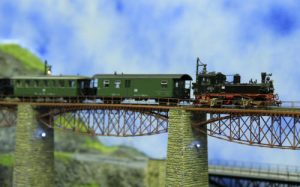 leaves Tschagguns and crosses a large viaduct with the river far below. On the far side, the line splits with one line heading to the Drunkens Brewery and the other reaching Lower Forthtal station. The line then disappears into further tunnels to continue the journey down the valley. Look out for the working road vehicles running along the layout crossing the valley by a traffic light controlled single lane road bridge. Trucks and buses use the Faller road system.
leaves Tschagguns and crosses a large viaduct with the river far below. On the far side, the line splits with one line heading to the Drunkens Brewery and the other reaching Lower Forthtal station. The line then disappears into further tunnels to continue the journey down the valley. Look out for the working road vehicles running along the layout crossing the valley by a traffic light controlled single lane road bridge. Trucks and buses use the Faller road system.
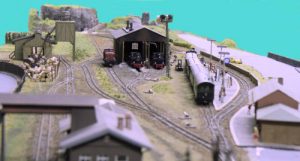
Forthal Schmalspürbahn means Forth Valley Narrow Gauge Railway.
Photographs © Thistle Modelmakers
Grime Street (OO)
Grime Street is a grittily realistic representation of the trams and buses of Leeds City Transport in the period 1948-1955. Watch out for the cyclist – oh, and there is a railway in the background!
Grime Street was featured in British Railway Modelling in April 2016.
Heatherley (N)
Heatherley is a layout of a fictitious location, built by members of the Leyland Model Railway Club as a multi-era layout to accommodate the stock available from members.
 At one end is a town, featuring many scratch built as well as proprietary buildings and a Faller working coach system. This leads into a dock area which has scratch built warehouses, 2 bridges and a country pub complete with beer garden.
At one end is a town, featuring many scratch built as well as proprietary buildings and a Faller working coach system. This leads into a dock area which has scratch built warehouses, 2 bridges and a country pub complete with beer garden.
From here it moves in to farmland, complete with an array of farm buildings and animals, through which the branch line meanders for use in commuting as well as providing a means for stone trains to access the quarry.
The quarry features buildings, workshops and a batch plant which loads stone into waiting hoppers and wagons. These are shunted to make complete trains again ready to be moved onto the main line for onward shipping.The track work is a double main line with a single branch line using Peco flexitrack and streamline points, the points are changed using Peco point motors.
Kepier Colliery (OO)
The layout represents a typical Durham Colliery and 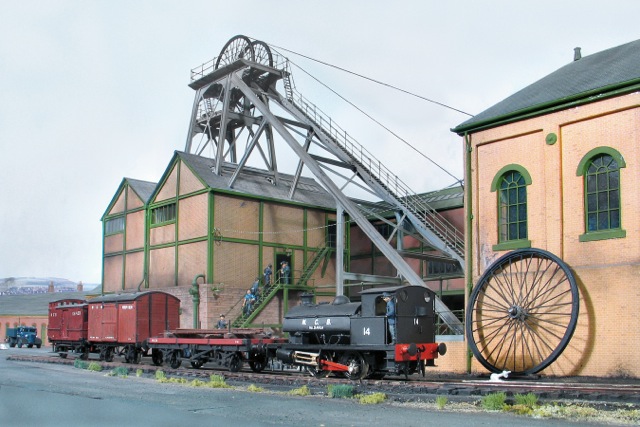 Railway system in the early 1960’s. Buildings are from various Lambton, Hetton and Joicey Collieries, with the exception of the upcast shaft which is based on South Hetton Colliery. The buildings have differing ages but reflect what a colliery system would look like in NCB days and the housing, shops etc are also based on a colliery village of the period. Kepier Colliery was situated at Gilesgate Moor, Durham City and was sunk in 1818-1822. It closed in the 1880’s and was totally demolished. As I lived in the vicinity I have called the layout KEPIER, projected it as still operational and part of a larger colliery group (like the L.H. & J. Collieries) which existed into NCB ownership. It would have been part of National Coal Board, Durham Division, Area No 5 (Mid West Durham).
Railway system in the early 1960’s. Buildings are from various Lambton, Hetton and Joicey Collieries, with the exception of the upcast shaft which is based on South Hetton Colliery. The buildings have differing ages but reflect what a colliery system would look like in NCB days and the housing, shops etc are also based on a colliery village of the period. Kepier Colliery was situated at Gilesgate Moor, Durham City and was sunk in 1818-1822. It closed in the 1880’s and was totally demolished. As I lived in the vicinity I have called the layout KEPIER, projected it as still operational and part of a larger colliery group (like the L.H. & J. Collieries) which existed into NCB ownership. It would have been part of National Coal Board, Durham Division, Area No 5 (Mid West Durham).
The layout was featured in Hornby Magazine in Dec 2015 and is in the Railway Modeller 2016 Annual.
Photograph © Railway Modeller
Llantwy (OOn9)
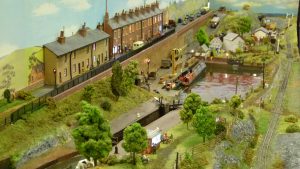 Llantwy is a fictitious Welsh country town serviced by a canal and a narrow gauge railway. The time period of the layout is the latter part of the 1930s.
Llantwy is a fictitious Welsh country town serviced by a canal and a narrow gauge railway. The time period of the layout is the latter part of the 1930s.
The buildings are all scratchbuilt as are all of the engines and 80% of the rolling stock, none of which are from specific plans, just a very fertile imagination!
Melton Mowbray (North) (N)
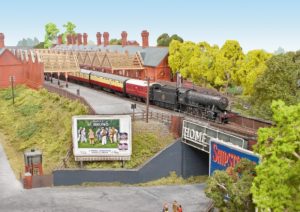 The line through Melton Mowbray was a joint venture between the Great Northern and London and North Western Railway companies, opening for traffic in 1879. Traffic was diverse, coal and ironstone being the two major minerals conveyed by the railway, and, during the hunting season, the aristocracy would send their mounts and later arrive themselves at the rather grand station on the north of the town centre, very near to the cattle market which was also a major source of trade in the town. After WWII the line gradually fell into decline and local passenger trains were terminated in 1953. However, during the summer months, excursions from Leicester to the east coast resorts, particularly Skegness, were a feature at the weekends. Freight traffic continued until the final closure in 1964. Sadly, little remains of the railway and this model is a tribute to its former glory.
The line through Melton Mowbray was a joint venture between the Great Northern and London and North Western Railway companies, opening for traffic in 1879. Traffic was diverse, coal and ironstone being the two major minerals conveyed by the railway, and, during the hunting season, the aristocracy would send their mounts and later arrive themselves at the rather grand station on the north of the town centre, very near to the cattle market which was also a major source of trade in the town. After WWII the line gradually fell into decline and local passenger trains were terminated in 1953. However, during the summer months, excursions from Leicester to the east coast resorts, particularly Skegness, were a feature at the weekends. Freight traffic continued until the final closure in 1964. Sadly, little remains of the railway and this model is a tribute to its former glory.
The model is run in two eras. The first is from 1948 to 1953, showing the line as it was with local passenger and freight traffic regularly passing through. However, we also imagine what things might have been like between 1957 and 1962, had the line come under the supervision of the Midland Region of British Railways following the modernisation plan of 1955, and seen the dawn of the diesel age. In an attempt to revive usage, we imagine through trains were re-introduced from Rugby to both Nottingham and Newark, the latter accessing the East Coast Main Line.
Melton Mowbray (North) has been featured in Hornby Magazine in Jan 2012 and Railway Modeller in Sept 2014.
Photograph © Steve Flint, Railway Modeller
Murfitt (3mmFS)
Murfitt is a work in progress which shows what can be achieved in this attractive and under-represented scale of 1/100. It represents a station on the Great North of Scotland Railway and the operators will be very happy to tell you more of its construction, and to demonstrate the techniques used.
Museum of Transport (mostly OO)
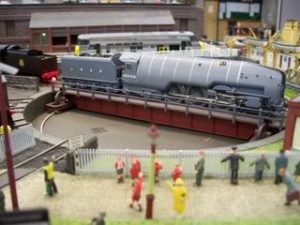 This popular 4mm layout consists of a fictitious Museum of Transport situated in the former dockland of a town, somewhere in England. Railway exhibits are housed in a purpose-built Railway Gallery where may be found historic and unusual locomotives, carriages, signals, models and other railway artefacts. The building is glass-fronted with the roof removed for maximum visibility.
This popular 4mm layout consists of a fictitious Museum of Transport situated in the former dockland of a town, somewhere in England. Railway exhibits are housed in a purpose-built Railway Gallery where may be found historic and unusual locomotives, carriages, signals, models and other railway artefacts. The building is glass-fronted with the roof removed for maximum visibility.
4mm electric tramcars operate on a double track around part of the layout that also includes the Road Gallery housing an extensive collection of classic motor vehicles, and the tramway depot. A miniature railway (based on N-gauge) operates around this area and beyond.
A diesel railcar operates to and from the Railway Gallery along the dockside line, crossing over the two branch docks by a bascule bridge and then a swing bridge. In the first dock is moored a freelance Edwardian passenger steamer St Olaf and a retired coastal lightship, based on the Spurn Light. A second deep-water dock features additional exhibits. A canal basin is included in this area with a working canal boat. A ‘green’ area features bandstand, displays of visiting vintage vehicles, a hot-air balloon and a childrens’ (T) gauge railway. The locomotive shed is the operational base for the standard gauge exhibits and visiting locos. The line from the engine sheds runs the entire length of the layout and is operated by DCC, with many of the locomotives featuring digital sound.
Photographs © Robin Brogden
Portchullin (P4)
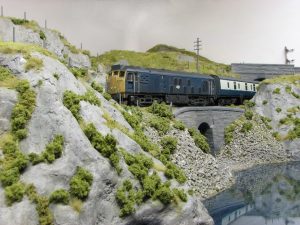 Portchullin (pronounced Port-who-Lun – for those without the gift of the Gaelic!) is a small through station on the single track Dingwall & Skye Railway, which became part of the Highland Railway and is now generally known as the “Kyle Line”.
Portchullin (pronounced Port-who-Lun – for those without the gift of the Gaelic!) is a small through station on the single track Dingwall & Skye Railway, which became part of the Highland Railway and is now generally known as the “Kyle Line”.
It is set in August 1974, the blue diesel era and is modelled in 4mm/1ft with a track gauge of 18.83mm.
Portchullin has featured in both Rail Express and Model Railway Journal and further details can be found at www.highlandmiscellany.com
Salmon Pastures (OO)
Whilst growing up in Sheffield it was a constant source of amusement that one of the scruffiest areas of the city had such a rustic name as “Salmon Pastures”.
The layout, Salmon Pastures, is a figment of my imagination and I have tried to capture the atmosphere of Sheffield in the mid 1930’s which in my opinion was the heyday of steam power, however most of the buildings are based on photographs from Sheffield Libraries wonderful photographic archive of the city I remember.
An engine shed served several key functions as well as supplying coal.
It was where engines were cleaned, stored, maintained, replenished with water, sand and coal, and then turned in the right direction for the next duty. As Sheffield was served by both the LNER & LMS you will see engines of both companies.
The engines are a mixture of straight out of the box, or highly modified, and several kit and scratch built. The layout started life as a test track whilst working in Bahrain, by the time the contract ended it had transformed itself into an engine shed and as it had supplied me with endless hours of enjoyment I did not have the heart to scrap it and so shipped it back to UK, so Salmon Pastures now has its own KLM Air Miles!
It appeared in British Railway Modelling in May 2009.
Photograph © Tom Foster Photograph © Alan Davies
Seabury Town and Preservation Society (O)
Seabury Town is a fictitious location, with an L.M.S. theme. It was also decided to make it a preservation society, as this would allow other club members to run their stock on it.
It was originally built to prove that: a) baseboards need not be heavy and built like bridges; b) you don’t need expensive multi pin plugs to connect them; and c) you don’t need a bottomless purse to have an O gauge layout!
All stock was built from kits, or bought second hand and refurbished. The buildings are based on actual prototypes, the station being a copy of Darley Dale and the goods shed is a copy of the one at Eckington.
The layout hosts what is believed to be the world’s smallest working model railway layout and there are many other animatronic special effects – ask to see them!
Shasta (Z)
The torturous curves of the Union Pacific’s former 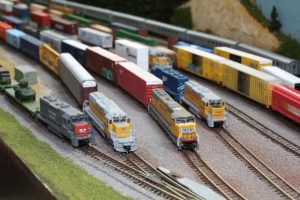 Espee line through the scenic Shasta sub-division is the setting for long intermodal and merchandise trains, with multiple diesel locos on the front, which grind round the curves of Cantara loop and Shasta springs with some pausing at the division point of the station at Dunsmuir for a crew change.
Espee line through the scenic Shasta sub-division is the setting for long intermodal and merchandise trains, with multiple diesel locos on the front, which grind round the curves of Cantara loop and Shasta springs with some pausing at the division point of the station at Dunsmuir for a crew change.
The Z scale layout features modern locomotive and rolling stock from the new generation of Z scale manufacturers like AZL, MTL, Full Throttle and Robert Ray, in which the running qualities and detail match the best of any of the larger scales
The layout has been featured in Continental Modeller and in Ztrack.
Photograph © Kev Smith
Sodor North-Western (OO)
The long awaited extension to the railway on the top left corner of the Island of Sodor is nearly complete and there is an urgent need of new footplate crew. Driving practice for anyone who wants to join the Sodor Railway Company will take place at the Barnes Wallis building during the first weekend of December.
The End of the Line (O and On14)
The End of the Line represents the distribution point of a very small coal mining operation in the early 1960’s. Never very busy, the output of the mine is divided between distant industry, transported away by rail and local demand which is handled by road haulage. The coal from the mine is delivered to the distribution point by a 2ft narrow gauge railway.
The excellent KBscale tipper wagons have been made to operate and discharge their load into either a conveyor or direct into a waiting standard gauge mineral wagon. The narrow gauge and standard gauge locomotives are mainly kit built but there are also some 3D printed bodied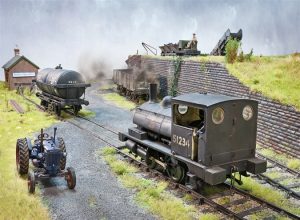 models from Shapeways and ready-to-run models from Ixion and Bachmann Brassmasters.
models from Shapeways and ready-to-run models from Ixion and Bachmann Brassmasters.
The layout has a scenic area of 5ft x 3ft. The grass is a mixture of Polak and MiniNature static fibres. Control of locomotives is by DCC as is the operation of a very heavily modified Hornby motorised conveyor and the Tortoise point motors.
The road haulage lorries are radio controlled and have been converted from commercially available die-cast models. They are powered by a replacement battery for an iPod Nano, a motor gearbox designed for miniature robotics and a micro servo for steering. The control is by a Deltang receiver under the bonnet and a controller/transmitter from a toy indoor helicopter.
The layout was originally built by Giles Favell but the stock and the lorries shown today are by the current owner. It has appeared in the spring 2013 issue of Model Rail and the March 2015 issue of British Railway Modelling.
Photograph © Tim Crockford
The World’s End (OO)
I started planning the project in 2009, and after extensive survey work and detailed planning model construction finally commenced in February 2010. It was completed at the end of 2014 and has been ‘on tour’ at model railway exhibitions since then. It has appeared in Railway Modeller and British Railway Modelling.
Set in the time period around 2005-2015, and beyond hopefully, running stock includes the modern day colourfully liveried DMU’s and several long special trains including the Northern Belle Pullman, Scarborough Spa Express and the Tour De France. Whilst it has a ‘modern image’ leaning, it has only a simple branch line theme with trains running through the station on a twin track continuous circuit run. There is one crossover that is used to reverse a few of the trains back in the opposite direction.
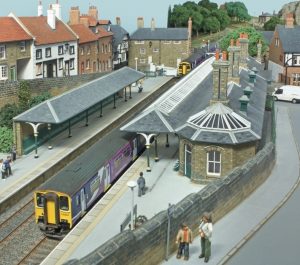 The market town setting contains a very strong historical theme to continue the military overtone created on previous layouts. A bold proposal, but the finished effect hopefully captures a charming contrast between a bustling market town and wooded countryside horizontally, and a sheer cliff face and river gorge vertically.
The market town setting contains a very strong historical theme to continue the military overtone created on previous layouts. A bold proposal, but the finished effect hopefully captures a charming contrast between a bustling market town and wooded countryside horizontally, and a sheer cliff face and river gorge vertically.
Photographs © Steve Flint, Railway Modeller
www.petegossrailwaymodelling.co.uk
Water Street Sidings (O)
Before the 1914-1918 war, most goods moved from their source by rail to local trans-shipment yards, where they would be transferred to road transport (usually horse drawn) for delivery to their destination. Small yards existed in every town, and there would be numerous examples in a city, with each railway company possibly having its own. Here there would be all manner of merchandise arriving and departing: parcels, hardware, foodstuff, perishables in casks, beer, timber, floorcoverings, road carriages and, sometimes, even livestock. The yards would often be cramped and clearances tight. The movement of wagons would require a sharp eye and a keen brain to prevent empty stock becoming trapped behind other wagons still being loaded.
Such a yard existed on Water Street, somewhere in the North of England. The time is 1910, the North Eastern railway is busy and the sun will never set on the British Empire…
The layout is an exercise in providing maximum detail in minimum space, designed to draw in the eye and features numerous cameos. It is challenging to operate and can keep an operator fully employed. Anyone who thinks they haven’t the space to consider modelling in ‘O’ Gauge should take a look at Water Street Sidings – and think again!

